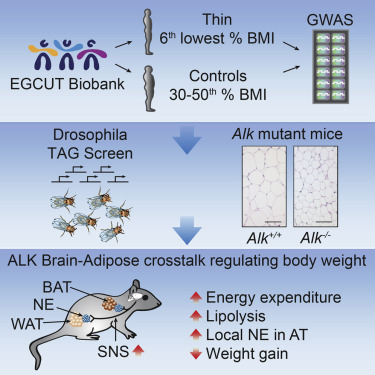Identification of ALK in Thinness
Michael Orthofer Cell May 21, 2020
Highlights
• GWAS in the EGCUT biobank identifies ALK as a candidate thinness gene
• Knockdown of Alk in Drosophila results in reduced triglyceride levels
• Alk mutant mice exhibit resistance to diet- and leptin-mutation-induced obesity
• ALK controls energy expenditure via sympathetic tone to the adipose organ
There is considerable inter-individual variability in susceptibility to weight gain despite an equally obesogenic environment in large parts of the world. Whereas many studies have focused on identifying the genetic susceptibility to obesity, we performed a GWAS on metabolically healthy thin individuals (lowest 6 th percentile of the population-wide BMI spectrum) in a uniquely phenotyped Estonian cohort. We discovered anaplastic lymphoma kinase ( ALK) as a candidate thinness gene. In Drosophila, RNAi mediated knockdown of Alk led to decreased triglyceride levels. In mice, genetic deletion of Alk resulted in thin animals with marked resistance to diet- and leptin-mutation-induced obesity. Mechanistically, we found that ALK expression in hypothalamic neurons controls energy expenditure via sympathetic control of adipose tissue lipolysis.
Our genetic and mechanistic experiments identify ALK as a thinness gene, which is involved in the resistance to weight gain.














